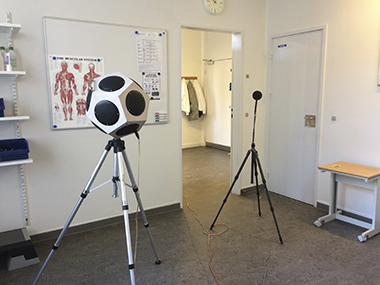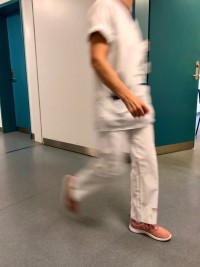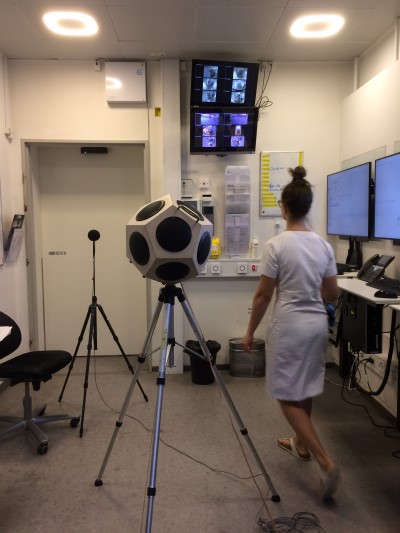
Danish study: 97% of hospital staff are sometimes disturbed by noise
A study in Denmark shows that sound environments in greater Copenhagen are challenged. Room acoustic measurements reveals that hospitals are getting noisier and noisier and a survey among the staff shows that the staff suffers.

Acoustic design engineer Thea Mathilde Larsen was the master mind of a recent project on hospital acoustics in Denmark and t is no secret that the process itself (to do acoustic research in a hospital) is a huge amount of work. Just getting into different wards with the acoustic equipment – at night – in the morning – all day – is a challenge. Hygiene demands have to be controlled, respect for nurses’ ‘peak hours’, respect for the patients, opening hours, arranging meetings with doctors, administration, cleaning personnel etc.
The buildings
The hospitals where the project took place were built in 1913 (Bispebjerg),1903 (Frederiksberg) and 1976 (Hvidovre) and they have together 7000 employees.
So what does it sound like in the hospitals today? Can the old buildings meet the demands of today? And what does the staff say about it? The short answer is – non of the rooms are not fulfilling the demands and the staff complains.
If you want to read more about this, watch a video and look at the acoustic results, please read the following article; What does long reverberation time sound like?
Questionnaires and interviews
 In the final report, Thea Mathilde Larsen writes that the interviewed staff at Hvidovre Hospital reported that noise was a large problem and especially came from MR-scanners, a technical room to which the door was closed most of the time, and human voices. They expressed that it was especially noisy when all five MR-scanners were running at the same time.
In the final report, Thea Mathilde Larsen writes that the interviewed staff at Hvidovre Hospital reported that noise was a large problem and especially came from MR-scanners, a technical room to which the door was closed most of the time, and human voices. They expressed that it was especially noisy when all five MR-scanners were running at the same time.
It was mentioned that it was sometimes hard to focus on writing reports due to noise, but that they had a room with glass walls in which they could withdraw for writing reports and similar tasks. However, the room was adjacent to the waiting room, which caused that patients would tap the glass wall to ask questions.
Always affected by noise
Furthermore, Thea Mathilde Larsen found that the staff always were on call, also when they were eating lunch or taking a break. The influence of noise caused tiredness and sometimes headaches. It was also mentioned that some of them felt that they got used to the noise. One mentioned that she found it unprofessional that patients lying in the scanner and colleagues on the phone could hear them joke with one another, which she thought was due to the large room with many people.
At Bispebjerg Hospital the working environment representative in the the work and occupational medicine department informed that several in the departments experienced that noise was building up in the room, when they were many people present at the same time. Especially one colleague, who was hearing impaired could not eat lunch in the room because the voices building up gave her temporary tinnitus.

When talking to the secretaries working in the ambulatory of the occupational medicine department they told that a radio was playing constantly in the waiting room, to avoid that patients in the waiting room overhearing what was said in the examination rooms, which meant that privacy was 'solved' with adding more noise. Furthermore, the secretaries also mentioned that they found their office reverberant.
At the emergency department at the same hospital the secretaries said that the general noiselevels made it difficult for them to concentrate on their work and they said that they easily got interrupted. Their office was in connection to the nurses station that was often very busy and hectic due to nurses 'traffic', checking their screens, the phones ringing and communication in general.
At Frederiksberg Hospital the rehabilitation departmenthad had recently moved into three new rooms, and the staff members found that the rooms were too reverberant and uncomfortable acoustically. Especially one of the three rooms caused trouble (speech clarity was really bad) and the staff was concerned that the room would end up being used as storage, due to the poor acoustics.
What can be done?
The project shows a general trend in healthcare today - that older hospital buidlings cannot live up to todays demands in regards to sound and acoustics. The reason i complex, but we need to keep in mind that when these hospitals were built they supported different activity levels. Today we see more people ( = more sound sources) in the buidlings, they solve more complex tasks, they do it in less time, we see more advanced technical equipment (more noise) and the hospitals have turned into small 'cities' with activity around the clock.
What we haven't see yet is acoustic refurbishments that comply with the demands and regulations of today. But it IS possible to make sound environments better for both staff and patients - find your inspiration here.
